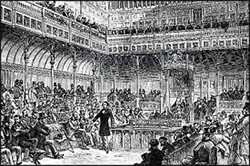The United Kingdom's Reform Act of 1867
The Reform Act 1867 effectively doubled the number of men in the United Kingdom who could vote. The passage of this bill came after lengthy and vociferous discussion, in Parliament and out. The Reform Act 1832 increased the number of available voters in Great Britain while also making voting more equitable. It did not, however, create universal suffrage. One of the issues that was consuming many in the U.K. in the 1850s and 1860s was electoral reform. The Reform Act 1832 had expanded the voter rolls by a few hundred thousand, but the number of people who could vote was still a small minority of the overall population. 
As early as 1860, Lord John Russell had introduced a new measure of parliamentary reform, one that would have set the rent qualification for county residents at £10 and for town residents at £6. Membership in Parliament was still overwhelmingly of the upper class, and their suspicions of the motivations and capabilities of the lower classes was evident. Many in the landed class were suspicious of giving trade workers too many privileges. Russell's proposal met with near universal opposition, including from then-Prime Minister Lord Palmerston. One prominent lawmaker who had changed his mind by the middle of the 1860s was William Gladstone, who had begun his political career as a member of the Conservative Party but was undergoing a shift in political thought in part influenced by the views and actions of John Bright, who had campaigned for the repeal of the and had become an advocate for universal suffrage (for men). Gladstone argued in favor of the reform bill in an 1864 speech in Parliament. The following year, a number of members of the International Workingmen's Association formed the Reform League, the goal of which was to bring about the vote for every man. Trade union leader such as William Allan and George Odger were leaders of this organization, which enjoyed financial support from Bright and the famous philosopher John Stuart Mill, himself an MP for Westminster. 
Palmerston, the longtime opponent of extending the franchise, died in 1865, and Earl Russell became Prime Minister. The very next year, Gladstone proposed what would eventually become the Second Reform Act. After weeks and weeks of furious debate and various amendments' being added and subtracted–not to mention a public gathering in favor of the bill that numbered in the tens of thousands of people–the House of Commons passed and the House of Lords validated the Reform Act 1867, on August 15 of that year. As a result, every male adult householder who lived in a borough constituency now had the vote, as did men who rented and paid £10 in rent. To the electoral votes were added 1.5 million voters. Another element of the Reform Act 1867 was that it eliminated one possible MP from each borough or constituency that had fewer than 10,000 residents; reassigned some of those to cities like Birmingham, Leeds, Liverpool, and Manchester who had yet to have an MP to call their own; added an MP to some counties who already had one but whose population had risen since the passage of the First Reform Bill; and added an MP for London University. Scotland gained seven new MPs but Irish representation remained the same. What this all meant in practice, however, again favored city-dwellers. Those living in boroughs paid rent and so now enjoyed a privilege previously held only by those who owned property; however, people living in rural areas still did not have the vote. As a result of the first two Reform Acts, only one-third of men could vote. Parliament debated a proposal to extend the vote to women (put forward by Mill) but did not include such a provision in the final bill. |
|
Social Studies for Kids
copyright 2002–2025
David White




